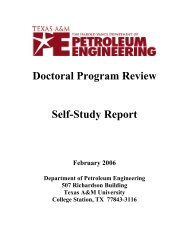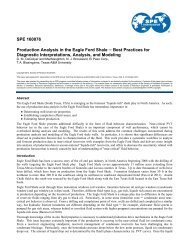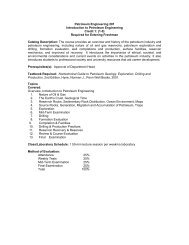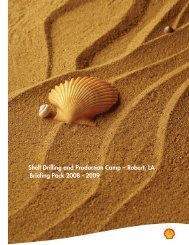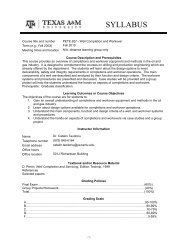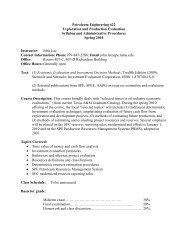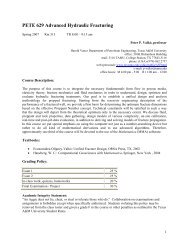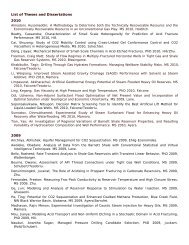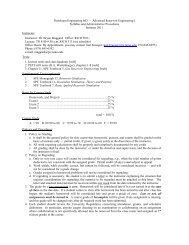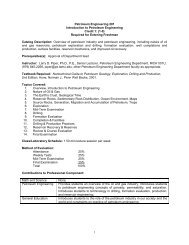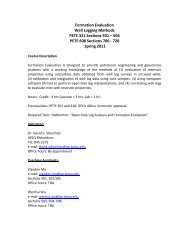Crisman Annual Report 2009 - Harold Vance Department of ...
Crisman Annual Report 2009 - Harold Vance Department of ...
Crisman Annual Report 2009 - Harold Vance Department of ...
You also want an ePaper? Increase the reach of your titles
YUMPU automatically turns print PDFs into web optimized ePapers that Google loves.
Performance Driven Hydraulic Fracture Design for Deviated Wells<br />
Introduction<br />
Unrestricted fracturing, long-established for lowpermeability<br />
reservoirs, is not applicable to highpermeability<br />
formations where the resulting width<br />
would be far less than indicated by rigorous design<br />
approaches such as the Unified Fracture Design<br />
(UFD). Thus, tip screenout (TSO) treatments are<br />
necessary, in which the lateral migration <strong>of</strong> the<br />
fracture is arrested followed by inflation <strong>of</strong> the<br />
fracture to the desired/optimum width. The term<br />
high-performance fracturing (HPF) better reflects<br />
the high performance standard targeted by this<br />
completion technique.<br />
Connectivity between the well and the fracture is<br />
a very important issue and has been addressed<br />
repeatedly in the literature. Because HPF’s dominate<br />
Gulf <strong>of</strong> Mexico well completions where well deviation<br />
angles established for extended reach drilling are<br />
maintained through the productive zone, the issue<br />
<strong>of</strong> well to fracture connectivity becomes even more<br />
serious. Ehlig-Economides et al. introduced a new<br />
model for hydraulically fractured wells, hypothesizing<br />
that only those perforations in the intersection<br />
between the far field hydraulic fracture plane and the<br />
wellbore actually connect flow through the fracture<br />
to the well. In turn, Zhang et al. introduced a new<br />
model allowing for flow both through the fracture<br />
and bypassing the fracture through perforation that<br />
are not connected to the fracture.<br />
Objectives<br />
This research is intended to provide new<br />
computational tools to quantify how the presence<br />
<strong>of</strong> the deviated wellbore open to flow impacts the<br />
expected performance <strong>of</strong> the hydraulic fracture,<br />
allowing a design <strong>of</strong> the system “deviated wellbore<br />
open to flow + transverse hydraulic fracture” to<br />
maximize overall productivity.<br />
Approach<br />
The problem is approached by combining the UFD<br />
technique with the “Method <strong>of</strong> Distributed Volumetric<br />
Sources” (DVS). We are developing a convenient<br />
implementation/methodology that will iteratively<br />
find the optimal fracture geometry that would result<br />
in a maximum productivity index <strong>of</strong> the deviated<br />
and fractured wells.<br />
Future Work<br />
We intend to carry on the following three main tasks:<br />
» Provide analytical/empirical expression(s) for<br />
the mechanical skin that includes all contributing<br />
factors such as well deviation, perforation density,<br />
phasing, penetration depth, diameter, minimum<br />
in-situ stress direction, proppant permeability,<br />
halo effect, production rate, and turbulence beta<br />
factors.<br />
» Provide analytical/empirical expression(s) for the<br />
composite productivity index (J D<br />
) that includes all<br />
previously mentioned major contributing factors.<br />
» Generate simplified correlations and benchmarking<br />
plots for the composite productivity index (J D<br />
)<br />
versus well deviation and reservoir permeability.<br />
CRISMAN INSTITUTE<br />
Project Information<br />
2.4.24 Hydraulically Fractured Well Performance in High<br />
Rate Wells<br />
Related Publications<br />
Economides, M. J., Oligney, R.E., and Valkó, P.P. 2002.<br />
Unified Fracture Design (hardbound). Houston: Orsa Press.<br />
Ehlig-Economides, C.A., Tosic, S., and Economides, M.J.<br />
Foolpro<strong>of</strong> Completions for High-Rate Production Wells.<br />
Paper SPE 111455, presented at the 2008 SPE International<br />
Symposium and Exhibition on Formation Damage Control,<br />
Lafayette, Louisiana, 13-15 February.<br />
Zhang, Y., Marongiu-Porcu, M., Ehlig-Economides, C.A.,<br />
Tosic, S., and Economides, M.J. Comprehensive Model for<br />
Flow Behavior <strong>of</strong> High-Performance Fracture Completions.<br />
Paper SPE 124431, presented at the ATCE <strong>2009</strong> SPE<br />
<strong>Annual</strong> Technical Conference and Exhibition, New Orleans,<br />
Louisiana, 4-7 October.<br />
Valko, P.P., and Amini, S. Method <strong>of</strong> Distributed Volumetric<br />
Sources for Calculating the Transient and Pseudosteady<br />
State Productivity Index <strong>of</strong> Complex Well-fracture<br />
Configurations. Paper SPE 106279, presented at the 2007<br />
SPE Hydraulic Fracturing Technology Conference, College<br />
Station, Texas, 29-31 January.<br />
Contacts<br />
Christine Ehlig-Economides<br />
979.458.0797<br />
c.economides@pe.tamu.edu<br />
Matteo Porcu<br />
<strong>Crisman</strong> <strong>Annual</strong> <strong>Report</strong> <strong>2009</strong><br />
59



